The Kyoto-based American artist Sarah Brayer has pursued her passion for traditional washi paper since the 1980s. To learn time-honored techniques from artisans she has made countless trips to Echizen, one of the oldest homes of washi. Her style of blending the traditional with her original vision has won her international acclaim. Recently, she received a rare chance to dedicate a fusuma-e, sliding partition paintings, to a Zen temple in Kyoto. Her 8-panel piece will be installed in the temple's meditation space. We follow Brayer's painstaking process to create a piece that will be treasured at the temple possibly for hundreds of years.
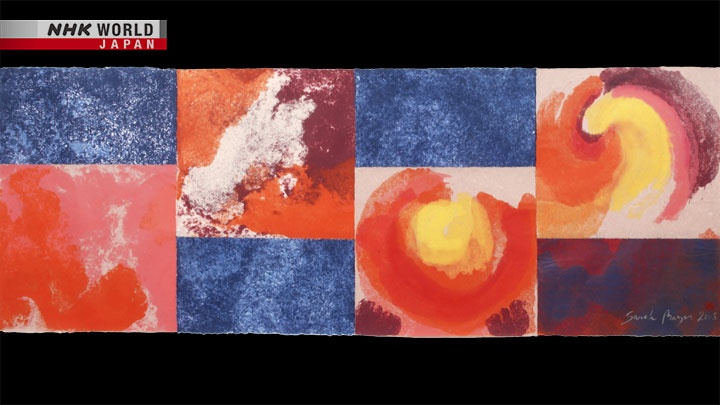
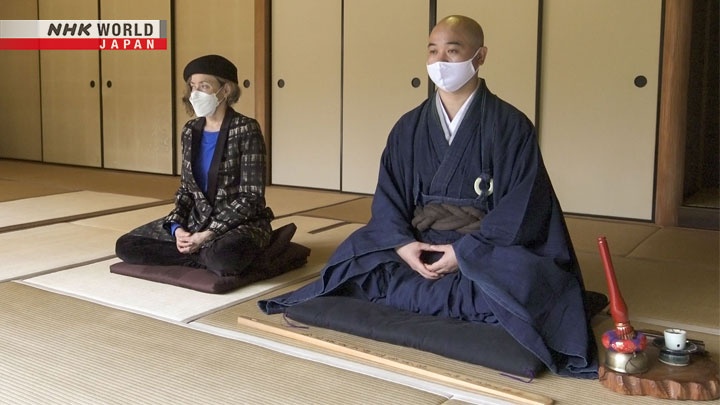
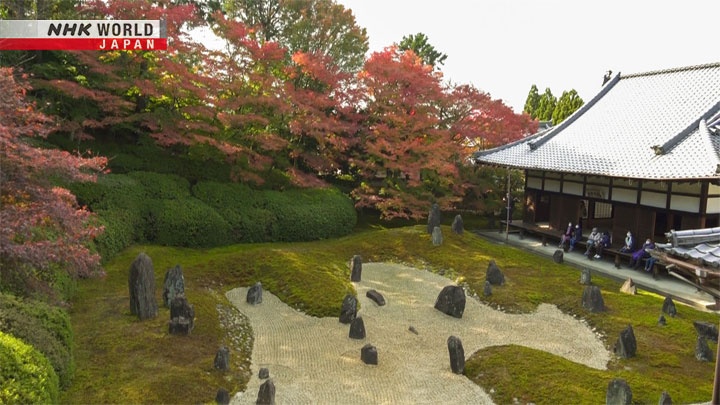
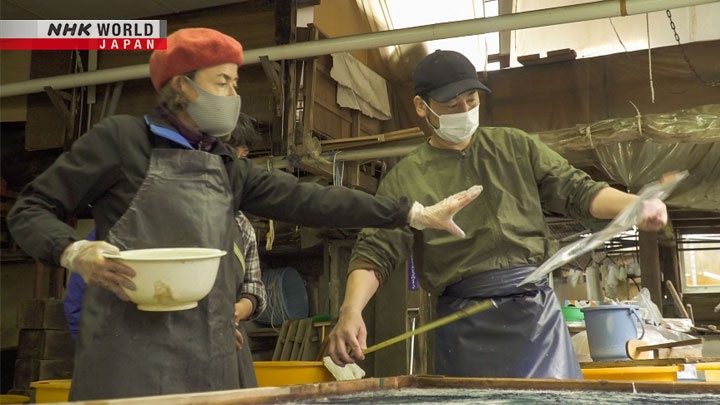
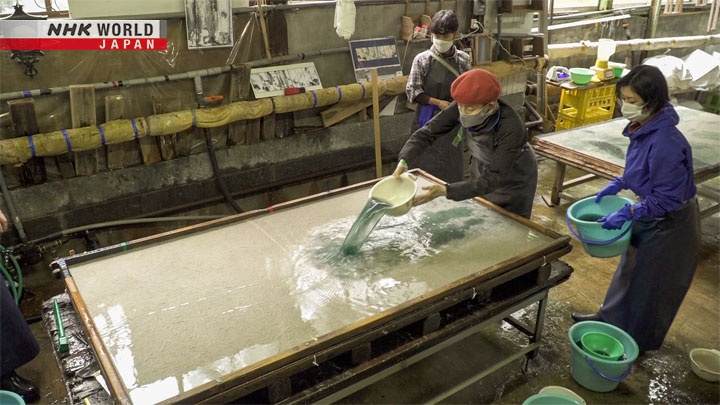
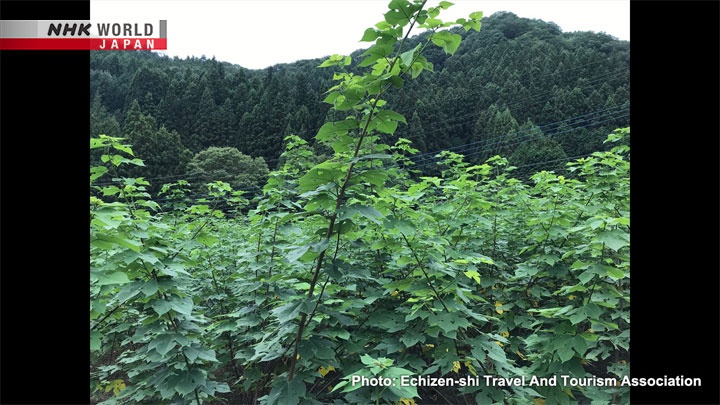
Transcript
American artist Sarah Brayer is on her way to a Zen temple in Kyoto.
Welcome.
Good morning.
It's been a while.
Fujita Keisui is the temple's abbot.
The morning light is stunning.
The garden is truly beautiful in the morning.
The moss, too.
Thank you for coming.
I would like you to create
new "fusuma" doors.
I would be honored.
Fujita is giving her complete artistic freedom to create a work on these eight-panel "fusuma" doors.
This is a place where people often meditate,
facing this garden.
I would be happy if your piece resonates
with people sitting here.
That's a huge challenge.
Your creation will add
another layer of meaning to this place.
The 600-year-old Komyoin temple is famous for this rock garden.
The rocks suggest mountains or islands.
The raked gravel - a flowing river or the sea.
But interpretation belongs...
to the eyes of the beholder.
Brayer's installation will live on here for years.
For her, this is a once-in-a-lifetime opportunity.
The ancient capital of Kyoto flourished as the center of arts and culture for over 1,000 years.
Just outside its center, Brayer maintains a home and studio.
Her work celebrates washi, the traditional paper made with plant fibers.
It's kind of my muse.
I am really attracted to just the beauty of the material.
One of the things I really love about washi is the many manifestations,
from the very, very thin to something thicker, that has a lot of fiber.
Bold movement, vivid colors...
And luminous pigments...
all define her work.
Her aesthetics meet ancient techniques.
Her work is recognized internationally, showcased in commercial spaces...
and collected in prestigious museums.
I've worked with washi now for number of years and I am still,
I still come up with new territory, or new ideas.
The artist fell in love with Japan while backpacking after graduating from college in 1979.
Having studied printmaking, her interest gradually shifted to the washi paper itself.
And then, a chance encounter changed her life.
Hello. It's been a while.
Have you seen this one before?
Only our family can make it.
We produce this type
once every decade.
Did you make this
recently?
It was Taki Yoshihiro who took her deep into the world of washi.
You first came in asking for paper
for print-making.
I was living near here.
Then I asked if you knew
any washi makers.
So, I said my family were washi makers.
Taki invited her to Echizen, an ancient washi home with 1,500 years of history.
At the family mill, artisans took her under their wing...
...showing her the traditional techniques.
Over the years, they supported Brayer in establishing herself.
My eyes opened wide...
I felt this is my dream place.
Looking back, my history with
washi is all thanks to you.
I've kept going to your mill all these years.
I'm so grateful.
Komyoin's Fusuma...a blank canvas, looms large...
This is not a museum or gallery...
but a spiritual space where people seek peace.
Brayer keeps working with the image of flowing water.
She is pondering how to express that concept for the Zen temple.
Architect Fujiwara Masato, has been quietly watching over his life partner's artistic endeavors.
He knows what this project means to her.
A work reflects the artist's state of mind.
Her piece may be kept at the temple
for decades to come.
She is braced up for the challenge.
This will be a landmark in her long career.
Tender, isn't it? Because it's autumn?
In search of inspiration, Brayer travels to the island of Yakushima,
known for its cedars...
and waterfalls.
To get closer to her image, she makes dozens of sketches.
But she is still searching...
Brayer has been contemplating the "fusuma" for more than a year now.
Please sit next to me.
It's important to open your heart to accept
all that comes to your mind.
You hear the sound of water, but you don't cling to it.
You just become at one with it.
And sit... just like the rocks, the gravel.
Thank you.
I realize that sitting here,
and sensing the space is so important.
It really helps me to feel
the flow of air and to hear the sounds.
And I also felt how this building supports those meditators who are doing Zazen
and how the Fusuma can be part of that support.
So, the water is flowing and it's flowing in a certain direction,
and that feeling of the garden is flowing, and then,
also there is flowing coming from the space behind us.
I think... that could be really, yeah, really it...
Brayer suddenly sees it.
Her "fusuma" should be entirely fluid with the temple space and its life
- not a stand-alone installation.
Brayer heads back to the source of her artistic life in Japan.
Echizen, the seat of washi production...
It's the day! Big day!
Sure, it's going be a great day.
Oh, Taki-san!
Hello, long time no see.
Indeed.
Taki Ryuichi, who warmly accepted Brayer into his workshop nearly 40 years ago...
Long time!
You look well.
I'm great.
And you, Sarah-chan?
I'm fine.
Ryuichi's son, Hideaki, now a master artisan,
affectionately calls her Sarah-chan like a sister.
For this project, I need to create 8 panels.
Which side do you want to start from?
From the left.
But, we will let the water do its thing.
These sketches are just a rough idea.
Just rough!
Brayer will be working closely with Hideaki
...and another veteran.
Both are familiar with the artist's style.
This viscous liquid, extracted from sunset hibiscus roots, is key in washi-making.
It's blended with pure groundwater.
Then, "kozo" fibers, from the inner bark of mulberry trees, are mixed in.
This artisanal process hasn't changed much from ancient times.
They use these wooden vats.
The team first pours in the fiber mixture to form a base.
As the water drains through a mesh screen,
the fibers interweave to form a sheet within minutes.
Brayer briefly meditates...
Whenever Sarah-chan is ready.
Are you ready?
Yes, I am.
The artisans start creating waves.
And now, the pigment fibers.
As the water flows, the fibers swirl around and settle where the water takes them.
I am kind of in the world of the water, and the water is making the design.
And I am just kind of feeding it, and letting it go.
In our work, we never make such bold moves.
Sarah-chan has an intuitive sensibility and just goes with it.
One piece, done!
It looks good.
I want to leave it as is and
go on to the next one.
This looks great.
The washi is left to dry.
She chose a subdued palette.
And in a departure from her signature style, she left in negative space...
for interpretation.
This looks great.
Gorgeous.
I went too far.
Perhaps.
But, it was fun.
Sara-chan is in great form.
Yet this panel, Brayer feels, may be too overpowering.
She wants a continuous flow throughout all 8 panels.
To realize this, they will create currents by pouring from different directions.
If you pour it in the center,
won't it flow like this?
Some of it will rebound anyway.
Like that?
A little.
So, I'll pour mine in the same direction.
From the center.
You mean like this?
This is the decisive moment.
The water will vanish within mere minutes.
The American artist and Echizen artisans are in the moment, transcending time, space and borders.
There is no way I can do that myself.
It's like music actually, or like dance.
Each person who touches it, adds something to the process,
like his love, and her attention, and her watching: you know, everyone is supporting.
It's kind of like giving birth to something.
The team ends up producing 16 sheets.
Once dried, Brayer will select the 8 and configure them for the installation.
In Japan, Buddhist temples are facing a crisis -
decreasing population and disinterest among young people.
Good morning.
Abbot Fujita is working to reinvigorate the world of Buddhism.
He reaches out and listens to the voices of the younger generation through classes on Zen in a university.
Think about the preciousness of life.
And what you can do to contribute.
Fujita talks about how in the past,
temples also promoted culture and education for all.
He would like to see them regain this role in a more diverse Japan.
He recalls how one of Brayer's works caught his eye.
At an exhibition, I was led to a pitch-dark room.
There, a crescent moon appeared.
I realized it was made of washi with luminous pigments.
Washi is a tradition of Japan.
Brayer is American, but has devoted her life to washi art.
That appealed to me.
I want my temple to be a place where people from all over can gather and experience art and culture.
It's the "fusuma" installation day.
What a strong presence.
I see so much movement.
Like water droplets spraying everywhere.
Water from the fall cascades down,
then splashes and flows into the garden.
That's true.
This is where the water flows out.
I am very pleased.
Thank you.
The pleasure is
all mine.
Guests from near and far gather to celebrate the fusuma's dedication.
She brings her American artistry, her American thoughts to something traditional - Japanese Washi.
But it has created something so new.
So, what do you think?
Looks great.
The Taki family from Echizen are here to share this moment.
Echizen washi has a history of 1,500 years.
And we hope to it pass on another 1,500.
This work is very meaningful.
It will endure here.
We must carry on making our washi.
It's a great honor.
This is a really historical, incredible place with years of practice and years of history, masters, you know,
to have your work in that surrounding is kind of unbelievable.
"What's your wish for the fusuma?"
That people can have a dialogue with them.
And that it supports the practice here.
That's actually really important.